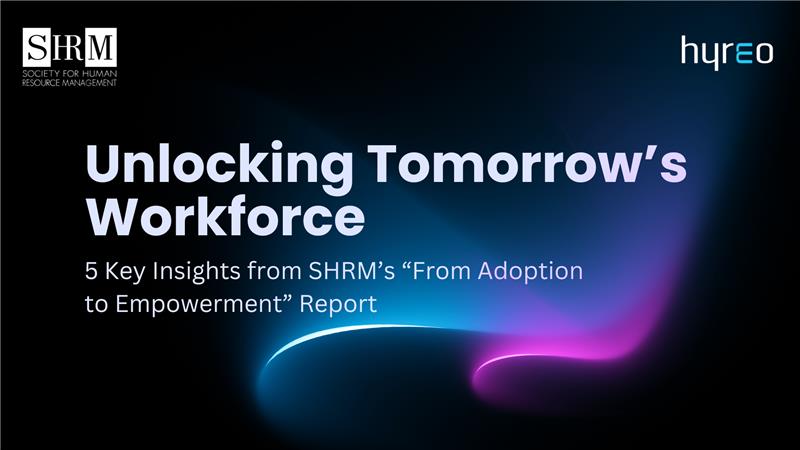Introduction
We’re in the middle of a massive workplace transformation driven by AI. What once felt like a far-off concept is now reshaping our daily workflows, helping businesses move faster, smarter. Companies aren’t just dabbling in AI anymore. They’re diving in headfirst, leveraging it to boost productivity, drive innovation, and stay competitive in an increasingly tech-forward world.
But it’s not all smooth sailing. With all the promise AI brings, there are real challenges too, like preparing the workforce, closing critical skill gaps, and ensuring implementations are ethical, inclusive, and human-centered.
That’s where SHRM’s latest report, “From Adoption to Empowerment: Shaping the AI-Driven Workforce of Tomorrow”, comes in. Based on insights from over 1,800 U.S. workers and nearly 2,000 HR professionals surveyed in early 2025, the report uncovers how organizations are currently adopting AI, where they’re struggling, and what’s working. More importantly, it outlines a path forward—one that blends tech innovation with people-first practices.
In this blog, we break down the five most important takeaways from the report that every HR leader, business decision-maker, and forward-thinking employer should know. Dive in.
5 Crucial Takeaways from SHRM AI Adoption 2025 Report
-
AI Is Gaining Ground. But Not Everyone’s on Board Yet
AI is already woven into many aspects of today’s work. But according to SHRM’s report, its usage isn’t as widespread as you might think. Only 45% of U.S. workers say they currently use AI in their roles, meaning more than half are still untouched by AI tools in their day-to-day work. The numbers reveal even deeper disparities when you zoom in on demographics.

Millennials are leading the AI charge, with 56% saying they actively use it at work.
Gen Z follows at 47%, while Gen X sits close behind at 45%.
Only 25% of Baby Boomers and Traditionalists report using AI in their jobs.
Gender differences also show up in the data. Over half of men (52%) are using AI on the job, compared to just 39% of women. These gaps aren’t just numbers; they’re signals that organizations need to act. For AI to truly empower the workforce, businesses must ensure equitable access and support. That means creating training opportunities, offering inclusive onboarding for new tech, and designing strategies that help everyone get comfortable with AI, regardless of age, gender, or tech background.
But at the same time, McKinsey finds that employees are using AI far more than leadership expects, often for over 30% of daily tasks.
Also read: AI Agents for Hiring: Industry-Wise Analysis
-
AI Supercharges Productivity and Work Quality
The SHRM report highlights AI as a true “productivity multiplier”, and the numbers back it up. 77% of AI users say they’re getting more done in less time, and 73% report delivering better-quality work with less effort. According to NNGroup, AI improves employee productivity by 66%. But here’s the catch: the biggest gains are happening in organizations that actually invest in their people.
When employees feel supported through upskilling and reskilling, the benefits of AI skyrocket. Among workers who are satisfied with their company’s training programs, 89% say AI helps them be more efficient, compared to just 48% of those who are dissatisfied. The trend holds for work quality too: 85% of well-trained workers produce higher-quality output with AI, while only 49% of poorly trained employees can say the same.

This means that handing out AI tools isn’t enough. To truly unlock AI’s value, companies must build strong learning cultures that prepare their teams to use these technologies confidently and effectively. In other words, better training is needed to produce better outcomes.
Also Read: Will AI Agents Replace or Liberate Recruiters?
-
AI Works Best with a Human Touch
According to the SHRM report, 74% of U.S. workers agree that AI should act as a complement to what humans uniquely bring to the table. That human-first mindset extends to how AI is implemented, too. A strong
80% of employees say that every AI-driven solution should be reviewed by a human before going live, reinforcing the need for ethical oversight and accountability.
77% believe human involvement is essential for AI to function at its best.
72% stress that AI’s success depends on how well the user understands and operates it.
Looking to the future, the ability to collaborate with AI is emerging as a critical skill. 66% of workers see it as a must-have.

The message is loud and clear: for AI to truly deliver value, it needs to be integrated thoughtfully, with humans steering the ship. AI-human collaboration is the key. LinkedIn highlights Deloitte findings, which say HR teams using collaborative AI models report 28% higher satisfaction with technology than those using fully automated solutions.
Also Read: Recruiting AI Agents: Your New Hiring Ally
-
HR Leadership Is crucial for Successful AI Adoption
AI implementation is a people challenge rather than a tech challenge. And that’s where HR steps in. The SHRM report makes it clear: successful AI adoption hinges on strong HR leadership and robust change management.
Despite the buzz around AI, only 17% of HR professionals rate their organization’s implementation efforts as “very” or “extremely” successful. One major reason for the low numbers is the lack of proper change management. Less than half (43%) of HR leaders say their organizations are following best practices for managing change during AI rollouts. But when those practices are in place, success rates soar. HR leaders are 2.6 times more likely to report positive outcomes.

Treating AI as just another tech upgrade is a mistake. It’s an organizational transformation, and it needs to be handled like one. Historically, HR hasn’t been front and center in AI initiatives; only 26% reported having a high level of involvement in driving change and employee adoption. But that’s quickly changing. A majority of HR professionals now see themselves playing a central role:
68% say HR should lead or co-lead AI-related change management
61% see HR owning employee training
55% believe HR should assess organizational readiness for AI
As AI reshapes how we work, HR’s strategic role in guiding adoption, training, and workforce alignment will be key to building inclusive, future-ready organizations. Once the adoption is done right, McKinsey estimates up to 30% of current work hours could shift due to automation.
Also Read: CHRO Outlook 2025: Top Priorities, Challenges, Visions and Trends
-
Upskilling & Reskilling: AI-Era Imperatives
If there’s one thing the AI revolution makes clear, it’s this: upskilling and reskilling are mandatory rather than optional. According to SHRM’s 2025 report, more than half of U.S. workers (51%) believe that the most important step organizations can take to improve AI adoption is to invest in better training and upskilling programs.
Other priorities workers identified include smoother integration of AI with existing workflows (43%) and clearer communication around what AI is, what it does, and how it benefits them (42%).
But the push for learning isn’t just about performance—it’s about job security and career survival. Nearly half of U.S. employees say they face moderate to severe risks to their job security (48%) and career growth (49%) if they don’t skill up in AI. For Gen Z, those numbers climb even higher—62% worry their careers could stall without the right AI skills.
While 63% of workers say they’re generally satisfied with their current AI training opportunities, satisfaction spikes in organizations that get the human+AI balance right. In companies where AI is seamlessly integrated with human workflows, an impressive 97% of workers are happy with their training. On the flip side, dissatisfaction often stems from a lack of clarity on how to use AI in real-world tasks (62%) and limited time allocated for learning (59%).

For AI adoption to succeed, organizations need to go beyond generic courses. They need to deliver accessible, practical, and role-specific training that builds both confidence and capability, empowering employees to thrive in an AI-enhanced workplace. In fact, Gallup and Workhuman find that 60% of workers learned a new skill because it helped them work effectively, and 51% saw it as an opportunity to learn and grow.
Also read: Optimizing Recruiting Costs: Key Drivers and Strategies
Beyond the Core Findings: What It Takes to Lead in the AI Era
While the promise of AI is massive, the risks of poor implementation are just as real. According to SHRM’s findings, HR professionals warn that failing to get AI right could seriously impact organizational operations (61%), reputation (54%), and long-term competitiveness (53%). The message? This isn’t just a tech upgrade—it’s a strategic priority.
To stay ahead, organizations need to think beyond adoption and move toward empowerment. The SHRM report offers clear guidance on what that looks like in practice:
Empower HR to lead AI integration and change management efforts
Track and measure ROI, especially since only 36% of organizations currently seeing positive returns from AI are actively monitoring it
Align AI initiatives with core business goals and risk mitigation plans
Prioritize transparency and communication, ensuring employees understand AI’s role and impact
Invest in inclusive, practical upskilling programs that reach every level of the workforce
Ultimately, the organizations that succeed with AI won’t be the ones that adopt the latest tools the fastest. They’ll be the ones that build trust, invest in people, and treat AI not as a replacement—but as a powerful partner in achieving their mission.
Also read: Top 10 AI Recruiting Software Tools to Streamline Hiring in 2025
Conclusion
SHRM’s “From Adoption to Empowerment” report paints a powerful vision of the AI-powered workplace; one full of promise, but not without its challenges. The key takeaway is: AI success isn’t just about the tech, it’s about the people.
When implemented with care and strategy, AI can unlock remarkable gains:
77% of AI users say they get more done in less time
73% report better work quality with less effort
But those numbers don’t happen by accident. They’re the result of organizations that invest in upskilling, build a culture of human-AI collaboration, and empower HR to lead the charge.
With nearly 7 in 10 HR professionals ready to take the reins on AI-related change, the stage is set. Now’s the time for organizations to move beyond experimentation and commit to AI strategies that are inclusive, ethical, and aligned with business goals.
Because the future of work is AI-driven and human-powered.
FAQs
- What is SHRM’s “From Adoption to Empowerment” report about?
The “From Adoption to Empowerment: Shaping the AI-Driven Workforce of Tomorrow” report by SHRM offers a comprehensive, data-driven look at how AI is being adopted in the U.S. workplace. Based on surveys from over 1,800 workers and nearly 2,000 HR professionals in January 2025, the report explores AI implementation trends, workforce readiness, and what it takes to make AI adoption successful and people-centric. - What are the biggest challenges organizations face in implementing AI successfully?
AI adoption comes with its share of roadblocks. The key challenges highlighted in the SHRM report include:
Uneven adoption across demographics like age and gender
Low confidence among HR professionals—only 17% report their AI efforts as highly successful
Lack of structured change management practices, which are critical for smooth rollouts
Concerns around operational disruption, reputational risks, and loss of competitiveness
Limited involvement from HR in the past, despite their pivotal role in driving AI-driven transformation
- How does Hyreo help organizations thrive in an AI-powered recruitment world?
Hyreo is built for the future of hiring, where AI meets human experience. The platform uses AI agents to streamline recruiting tasks, engage candidates 24/7, and deliver deep insights across the hiring funnel. From apply to onboarding, Hyreo helps recruiters work smarter, not harder, making hiring faster, more efficient, and more human at the same time.



